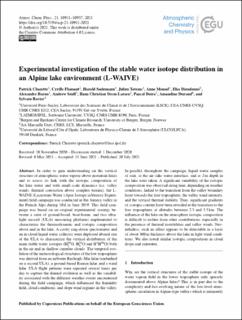| dc.contributor.author | Chazette, Patrick | |
| dc.contributor.author | Flamant, Cyrille | |
| dc.contributor.author | Sodemann, Harald | |
| dc.contributor.author | Totems, Julien | |
| dc.contributor.author | Monod, Anne | |
| dc.contributor.author | Dieudonné, Elsa | |
| dc.contributor.author | Baron, Alexandre | |
| dc.contributor.author | Seidl, Andrew Walter | |
| dc.contributor.author | Steen-Larsen, Hans Christian | |
| dc.contributor.author | Doira, Pascal | |
| dc.contributor.author | Durand, Amandine | |
| dc.contributor.author | Ravier, Sylvain | |
| dc.date.accessioned | 2022-03-29T08:52:39Z | |
| dc.date.available | 2022-03-29T08:52:39Z | |
| dc.date.created | 2022-01-12T15:58:58Z | |
| dc.date.issued | 2021 | |
| dc.identifier.issn | 1680-7316 | |
| dc.identifier.uri | https://hdl.handle.net/11250/2988206 | |
| dc.description.abstract | In order to gain understanding on the vertical structure of atmospheric water vapour above mountain lakes and to assess its link with the isotopic composition of the lake water and with small-scale dynamics (i.e. valley winds, thermal convection above complex terrain), the L-WAIVE (Lacustrine-Water vApor Isotope inVentory Experiment) field campaign was conducted in the Annecy valley in the French Alps during 10 d in June 2019. This field campaign was based on an original experimental synergy between a suite of ground-based, boat-borne, and two ultra-light aircraft (ULA) measuring platforms implemented to characterize the thermodynamic and isotopic composition above and in the lake. A cavity ring-down spectrometer and an in-cloud liquid water collector were deployed aboard one of the ULA to characterize the vertical distribution of the main stable water isotopes (H162O, H182O and H2H16O) both in the air and in shallow cumulus clouds. The temporal evolution of the meteorological structures of the low troposphere was derived from an airborne Rayleigh–Mie lidar (embarked on a second ULA), a ground-based Raman lidar, and a wind lidar. ULA flight patterns were repeated several times per day to capture the diurnal evolution as well as the variability associated with the different weather events encountered during the field campaign, which influenced the humidity field, cloud conditions, and slope wind regimes in the valley. In parallel, throughout the campaign, liquid water samples of rain, at the air–lake water interface, and at 2 m depth in the lake were taken. A significant variability of the isotopic composition was observed along time, depending on weather conditions, linked to the transition from the valley boundary layer towards the free troposphere, the valley wind intensity, and the vertical thermal stability. Thus, significant gradients of isotopic content have been revealed at the transition to the free troposphere, at altitudes between 2.5 and 3.5 km. The influence of the lake on the atmosphere isotopic composition is difficult to isolate from other contributions, especially in the presence of thermal instabilities and valley winds. Nevertheless, such an effect appears to be detectable in a layer of about 300 m thickness above the lake in light wind conditions. We also noted similar isotopic compositions in cloud drops and rainwater. | en_US |
| dc.language.iso | eng | en_US |
| dc.publisher | Copernicus | en_US |
| dc.rights | Navngivelse 4.0 Internasjonal | * |
| dc.rights.uri | http://creativecommons.org/licenses/by/4.0/deed.no | * |
| dc.title | Experimental investigation of the stable water isotope distribution in an Alpine lake environment (L-WAIVE) | en_US |
| dc.type | Journal article | en_US |
| dc.type | Peer reviewed | en_US |
| dc.description.version | publishedVersion | en_US |
| dc.rights.holder | Copyright 2021 the authors | en_US |
| cristin.ispublished | true | |
| cristin.fulltext | original | |
| cristin.qualitycode | 2 | |
| dc.identifier.doi | 10.5194/acp-21-10911-2021 | |
| dc.identifier.cristin | 1979730 | |
| dc.source.journal | Atmospheric Chemistry and Physics (ACP) | en_US |
| dc.source.pagenumber | 10911-10937 | en_US |
| dc.relation.project | Norges forskningsråd: 245907 | en_US |
| dc.relation.project | EC/H2020/773245 | en_US |
| dc.identifier.citation | Atmospheric Chemistry and Physics (ACP). 2021, 21 (14), 10911-10937. | en_US |
| dc.source.volume | 21 | en_US |
| dc.source.issue | 14 | en_US |

